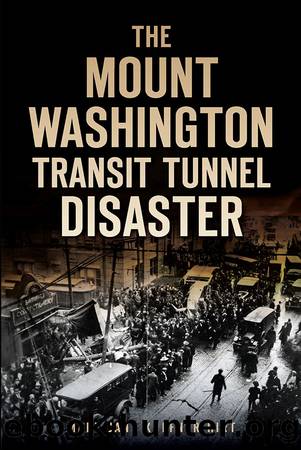The Mount Washington Transit Tunnel Disaster by Mary Jane Kuffner Hirt

Author:Mary Jane Kuffner Hirt
Language: eng
Format: epub
Publisher: Arcadia Publishing Inc.
Published: 2021-09-15T00:00:00+00:00
The Allegheny County morgue, Diamond Street. Courtesy of Archives & Special Collections, University of Pittsburgh Library System.
CORONERâS INQUEST
The coronerâs inquest convened on February 20, 1918. Well before the inquest began, the hearing room at the coronerâs office on Diamond Street was crowded to capacity with friends and family members of those killed or injured, Knoxville Borough and civic organization representatives and Pittsburgh Railways Co. officials and employees. Coroner Samuel Jamison presided. Allegheny County solicitor Richard W. Martin represented the commonwealth. William J. Brennen represented H.H. Klingler, and William D. Challener acted on behalf of the Pittsburgh Railways Co. William D. Grimes, attorney for Knoxville Borough, and Frank I. Gosser were also present at the counsel table.
Six local businessmen sat as coronerâs jurors: Eli Edmundson Jr., age sixty-six, stockbroker, 255 Meyran Avenue, Oakland; F.J. Bergold, age thirty-six, insurance broker, 1002 Bidwell Street, North Side; Jesse C. Davis, age forty-six, Alderman Fourteenth Ward/fire insurance agent, 5708 Darlington Road, Squirrel Hill; Clarence L. Saxton, age thirty-nine, real estate broker, William Penn Hotel, downtown; Michael J. McMahon, age fifty-four, printer, 2 Stowe Street, Ingram; and Harry Beegle, age forty-four, auto supply merchant, 5817 Phillips Avenue, Squirrel Hill.
The inquest started promptly at 10:00 a.m. Deputy Coroner George Ambos brought Herman H. Klingler into the room. Klingler was described as looking quite tired and nervous. Jamison called Klingler as the first witness and explained that he was not required to testify, but any testimony he gave could be used against him in court. The inquest was delayed until Klinglerâs attorney, William J. Brennen, arrived. Brennen recommended that Klingler not be the first to testify, but could at some point if other testimony made it necessary.
Twenty witnesses, including Pittsburgh Railways employees, accident victims and local businesspeople, were called. The clerkâs handwritten record of their testimony mirrored the news reports immediately following the accident and reflected a consistency of arguments that carried through to the trial. The following verbatim testimony from reporters at the inquest for some of the witnesses provides a sense of the inquiry. Jamison and Martin questioned the witnesses.
Martin Joyce, age twenty-two, was the conductor on Knoxville #4236 and the first to testify. A Pittsburgh Sun reporter recorded Jamison and Joyceâs dialog. Joyce started by stating: âI took the car at the south end of the tunnel. It was overcrowded, probably 118 passengers on the car. In fact, there were as many passengers as could get on. When the car proceeded into the tunnel about three or four lengths the trolley jumped off, and then the car stopped.â
Jamison asked, âWho put the trolley on?â
Joyce responded, âMotorman Leroy Hazelbacker of the Charleroi line.â
Jamison: âDid you see where the motorman was?â
Joyce: âNo.â
Jamison: âWhen did you notice that the car was getting beyond the control of the motorman?â
Joyce: âWhen it was about half way through the tunnel.â
Jamison: âCould you use your brake?â
Joyce: âNo, the car was so crowded with passengers that it was impossible.â
Jamison: âWhy did you let the car get overcrowded?â
Joyce: âThese passengers were permitted to get on the car by the other crew which we relieved at the tunnel.
Download
This site does not store any files on its server. We only index and link to content provided by other sites. Please contact the content providers to delete copyright contents if any and email us, we'll remove relevant links or contents immediately.
| Air & Space | Construction |
| Disability | Educational Law & Legislation |
| Labor Law | Maritime |
| Military | Personal Injury |
| Sports |
Last Narco by Beith Malcolm(1512)
Steroids: History, Science, and Issues by Standora Joan E.; Bogomolnik Alex; Slugocki Malgorzata(1480)
A Practical Guide to International Arbitration in London by Hilary Heilbron(1396)
Adrift by Steven Callahan(1320)
40 Days and 40 Nights by Matthew Chapman(1307)
Reclaiming History by Vincent Bugliosi(1291)
Introduction to the study and practice of law in a nutshell by Kenney F. Hegland(1290)
The Nuremberg Interviews by Leon Goldensohn(1274)
Persuasion by Owner(1269)
Poisoned by Jeff Benedict(1266)
Dog Company: A True Story of American Soldiers Abandoned by Their High Command by Lynn Vincent & Roger Hill(1232)
The New Whistleblower's Handbook by Stephen Kohn(1194)
Lincoln's Code by John Fabian Witt(1158)
Kafka's Last Trial by Benjamin Balint(1136)
Eichmann in Jerusalem by Hannah Arendt(1134)
Japanese War Crimes during World War II: Atrocity and the Psychology of Collective Violence by Frank Jacob(1068)
A Passing Fury by A. T. Williams(1048)
Dog Company: A True Story of American Soldiers Abandoned by Their High Command by Roger Hill & Lynn Vincent(1032)
A Court of Refuge by Ginger Lerner-Wren & Rebecca A. Eckland(1012)
